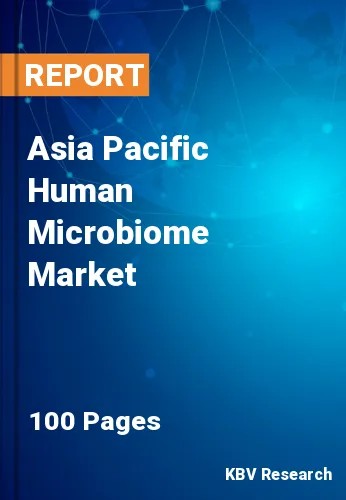The Asia Pacific Human Microbiome Market would witness market growth of 33.2% CAGR during the forecast period (2022-2028).
The human microbiome plays a vital role in the body's maintenance and development. In neonates and young children, these organisms are fundamental for activating the immune system, altering inflammatory homeostasis and immunological control. Children who acquire allergies later in life have a higher prevalence of anaerobic bacteria and Bacteroidaceae, as well as a lower count of Bifidobacterium bifidum, Bifidobacterium adolescentis, and Lactobacillus spp. These organisms engage with and digest external pollutants such as polycyclic aromatic hydrocarbons, heavy metals, herbicides, ochratoxins, organic chemicals, and plastic monomers. Toxins cleared from the bloodstream by renal filtration are retained in the bladder, which provides substrates and a favorable environment for the urinary tract microbiota to break down hazardous compounds. The interactions between these species influence the outcome of an infection. Indigenous microbial flora, which is responsible for initiating innate immunity, including secretions including cytokines, antimicrobial peptides, and inhibitory compounds, initiates the protective mechanism in the female genital tract.
The prevalence of diabetes is rapidly rising in this region. According to the World Health Organization, diabetes affects over 10% of all adults in China or approximately 110 million individuals. Without an immediate effort to address lifestyle risk factors, such as poor food as well as lack of physical activity, that number is likely to rise to 150 million by 2040, causing serious health, social, and economic implications. Various initiatives are being taken by the government in order to tackle the situation, for example, Beat Diabetes. This provides a chance to consider the causes of the disease's rising prevalence in China, as well as what might be done to reverse the trend. Type 1 diabetes, also known as juvenile diabetes, is characterized by a lack of insulin production and necessitates daily insulin injection. Type 1 diabetes has no recognized cause. The body's non-optimized utilization of insulin leads to type 2 diabetes. Type 2 diabetes affects 90% of diabetics is caused primarily by obesity and physical inactivity.
The China market dominated the Asia Pacific Human Microbiome Market by Country in 2021, and would continue to be a dominant market till 2028; thereby, achieving a market value of $84.6 million by 2028. The Japan market is estimated to grow at a CAGR of 32.4% during (2022 - 2028). Additionally, The India market would witness a CAGR of 34% during (2022 - 2028).
Based on Product, the market is segmented into Drugs, Diagnostic Tests, Probiotics, Prebiotics, and Others. Based on Disease Type, the market is segmented into Infectious Diseases, Endocrine & Metabolic Disorders, Gastrointestinal Diseases, Cancer, and Others. Based on Technology, the market is segmented into Genomics, Proteomics and Metabolomics. Based on Application, the market is segmented into Therapeutics and Diagnostics. Based on Type, the market is segmented into Microbiome Consortia Transplantation (FMT), Peptide, Live Biotherapeutic Product and Others. Based on countries, the market is segmented into China, Japan, India, South Korea, Singapore, Malaysia, and Rest of Asia Pacific.
Free Valuable Insights: The Worldwide Human Microbiome Market is Projected to reach USD 1.1 Billion by 2028, at a CAGR of 32.2%
The market research report covers the analysis of key stake holders of the market. Key companies profiled in the report include Seres Therapeutics, Inc., 4D pharma plc, OptiBiotix Health Plc, Synlogic, Inc., Second Genome, Inc., Vedanta Biosciences, Inc., Finch Therapeutics Group, Inc., Ferring Holdings SA, and Enterome.
By Product
By Disease Type
By Technology
By Application
By Type
By Country
Our team of dedicated experts can provide you with attractive expansion opportunities for your business.

